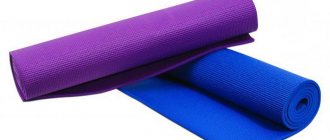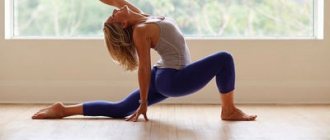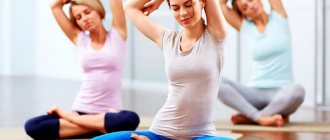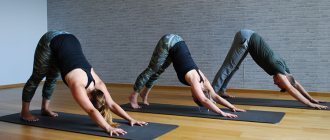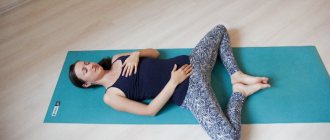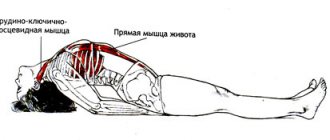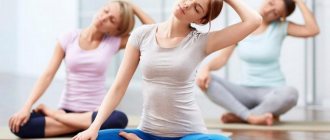Execution technique
- Starting position – Pranamasana (standing with hands folded in “Namaste”).
- Exhale and bend down and place your palms on the floor next to your feet. If you can’t do it with straight legs, you can bend them before your hands touch the mat.
- Take your right leg back as far as possible, bend the front leg.
- Stretch your spine forward.
- Push your pelvis forward and arch your back, and throw your head back. Press your lower abs toward your left thigh.
- Lightly touch the floor with your fingertips (or entire palm) to maintain balance.
- Turn your elbows back, move your shoulders away from your ears. Bend in the chest.
- Stretch from the hip up along the front of the body to the Ajna chakra.
- Hold your breath in the pose after inhaling and exhale. Inhalation, retention and exhalation should be the same in duration. Or is in a pose for 2-3 breathing cycles.
Reference! When practicing the fourth pose in Surya Namaskar, say “Om Bhanave Namaha”. When performing the ninth asana, pronounce the sacred saying: “Om Oditya Namaha.”
Pose for relieving headaches and developing muscle flexibility
Paschimottanasana (“back stretching pose”). Since physical education lessons, we know this exercise as “bending forward from a sitting position.” We sit on the floor, straighten our legs, connect them together, tilt our torso forward and try to hug our feet with our hands and touch our knees with our foreheads. Movements are smooth. Leaning forward, we fixate for 5-6 seconds. Inhale - in the starting position, in the fixation position - either holding your breath or breathing normally.
Photo: ShutterStock
Paschimottanasana develops flexibility in the muscles of the back, legs and abdominals, eliminates headaches, and also calms the nervous system.
Variations
Utthita Ashwa Sanchalanasana
It stretches the spinal column, opens the thoracic region and makes the legs stronger. Refers to traditional Hatha yoga. Translated from Sanskrit, “Utthita” means “raised” and “Ashwa Sanchalan” means “horse riding”.
- Take a horseback pose.
- As you inhale, raise your arms, joining your palms above your head.
- Tilt your body back, stretching the entire front surface of your body.
- Take several breathing cycles, trying to lower your pelvis lower to the mat.
- Do the same thing, changing the position of your legs.
In what order to perform yoga asanas
Encyclopedia of Yoga. Yoga is a way of life on earth. > Questions > In what order should you perform yoga asanas?
Is the order (sequence) in which we perform asanas important? Without a doubt!
Below we will give the main reasons why asanas performed in the correct sequence give a positive effect, but in a different sequence they can be either practically useless or even harmful and dangerous. For example, performing Sirshasana after Sarvangasana can lead to neck injury. In order to learn how to compose the correct sequences of asanas, you need to understand the mechanism of influence of each asana on:
- muscles and skeleton
- internal organs
- cardiovascular system
- endocrine system
- subtle energy
This awareness is the result of many years of practice, and until then we strongly recommend using ready-made complexes for authoritative Yoga Teachers. (You can read more here A. Safronov Mechanisms of influence of Yoga asanas.)
The main thing that you must understand is that a set of asanas is not a set of individual exercises that independently train different muscles and ligaments, but a single system that has a complex effect on different levels of our being.
Two examples.
Trikonasana - Plank. In the first asana, prana accumulates in anahata. The second (power) asana allows you to condense the collected energy. The reverse sequence makes no sense from an energy point of view.
Shirshasana - Matsiasana. The second asana normalizes intracranial pressure after the inverted asana. the reverse sequence makes no sense.
Energy mechanism of asanas
Until you have learned to directly feel the movement of energy, you can use a simple rule: energy moves from compressed areas of the body to stretched ones and from relaxed ones to tense ones. At the same time, you should not treat the concept of “subtle (etheric) energy” as an absolute abstraction or mysticism.
It is actually not difficult to distinguish “fantasy” work with etheric energy from real work. Etheric energy has a strong effect on the physical body, and any of its movements cause pronounced somatic effects: changes in temperature in certain parts of the body, the appearance of internal vibration (this happens when energy is “overflowed” into a certain area), and the disappearance of pain. If the listed effects are not observed, there is no real work with energy.
Several important rules for composing sequences of asanas
- The sequence of inverted asanas should only be as follows: 1) Shirshasana (headstand), 2) Sarvangasana (birch tree) or Viparita-karani, 3) Halasana (plough). It is not necessary to do all the asanas, but you cannot change their order - the likelihood of injuring your neck increases.
- After Sirshasana, you need to lie on your back for some time (do shavasana).
- After inverted asanas, it is necessary to perform Matsiasana , which normalizes intracranial pressure.
- Any yoga complex should end with Shavasana . Without Shavasana, your lesson turns into a set of morning exercises - which is also useful, but has nothing to do with yoga.
see also How to build your own sequence of asanas
Return to the list: Yoga - questions for beginners
Benefit
The exercise makes the leg muscles stronger and more resilient, the pelvic muscles flexible, and opens the thoracic region.
It massages the back and abdominal organs, calms the nerves, and this has a good effect on human health. When breathing, a lot of oxygen enters all organs, which allows them to function much better. The pose increases the volume of the lungs, helps strengthen the pectoral muscles, makes the spine and hip joints more mobile, increases the supply of blood to the spine and the nerves of the spinal cord, and has a good effect on the liver, kidneys, gastrointestinal tract, spleen, reproductive and urinary systems. Helps develop confidence, determination and perseverance. Removes toxic substances from the body that enter it through food.
Stimulates one of a pair of energy channels (Pingala or Ida), while the opposite channel is closed.
The energy released in the pelvic area activates the ajna chakra, and by inhaling prana rushes up the front energy channel and can be felt on the front of the thigh as it flows directly to the ajna chakra. This gives energy to the whole body.
Pose to strengthen your back muscles
Paripurna Navasana (“boat pose”, the notorious “boat”). An exercise to strengthen the back and abdominal muscles, as well as to normalize digestion and thyroid function. Sit on the floor and place your body weight on your sit bones. The angle between the legs and the floor, as well as the torso and the floor, should ideally be 45 degrees. You can fixate in the “boat pose” for 5-6 seconds and repeat this exercise several times, or you can fixate in this position for as long as possible (fixation for 2 minutes or more is considered a good result). Inhale - in the starting position, in the fixation position - either holding your breath or breathing normally.
Photo: ShutterStock
Contraindications
The practice is prohibited in the following cases:
- the presence of a pinched nerve in the lower part of the spinal column;
- if there are problems with the knee joint or ankle, then maximum stretching is not recommended;
- umbilical and inguinal hernias.
In late pregnancy, place your hands on the inside of the bent front leg, and then straighten the back leg if necessary.
If you find an error, please select a piece of text and press Ctrl+Enter.
Worth knowing about the practice
A set of exercises and breathing techniques called “Surya Namaskar” can easily be called a panacea for almost every modern person. The thing is that in the conditions of the world around us, many regularly face stressful situations and adhere to a semi-sedentary lifestyle, which negatively affects physical and mental health.
Surya Namaskar helps to restore vitality, improve health and achieve inner harmony and feel the healing energy of the Sun. This practice, which takes about 15 minutes to complete, can stretch and massage the core muscles of the body, as well as tone and stimulate the body's major vital systems. It has a beneficial effect on the person as a whole and therefore, in order to achieve the pursued goal, it is worth familiarizing yourself with each stage of the “Surya Namaskar” health complex.
It is worth noting that Hatha yoga, which is a separate direction of yoga leading to harmony, is based on static exercises. Therefore, Surya Namaskar is considered an important part of classical yoga, opening the way to improving one’s physical form and achieving spiritual balance.
Basic concept and execution steps
With inspiration already in its name, Sun Salutation is an excellent routine for beginners and those who want to start their day in a good mood. Since Surya Namaskar is rather a morning set of gymnastic exercises, it is best to practice it in the morning, when meeting the Sun. If it is not possible to allocate 5-15 minutes for yoga in the morning, you can do several cycles at a more appropriate time. However, keep in mind that classes must be carried out on an empty stomach (or 2-2.5 hours after eating).
The asanas that make up the main cycle of Surya Namaskar practice carry a certain meaning. A certain sequence of poses, the implementation of which is described in detail in the video with yoga lessons, helps to build an energetic “bridge” between you and the Sun through gratitude, respect and the desire for self-knowledge. Therefore, performing the cycle requires following a breathing technique that promotes relaxation and reading mantras that can bring you closer to the inexhaustible source of energy of the heavenly body.
Video lesson: Complex for preparing for Hanumasana
https://youtu.be/Mab8r2uC4MI
The most important thing in such difficult poses as Hanumanasana, Supta Padangusthasana, Utthan Prishthasana is to avoid injuries when preparing and performing exercises, so always warm up well, especially if you practice in the morning and at home. Remember the principle of non-violence towards your body; there should be no unnecessary pressure or forcing of events. The main key to success is regularity; it is better to do “gymnastics” for 15 minutes every day than 1.5 hours once a week.


